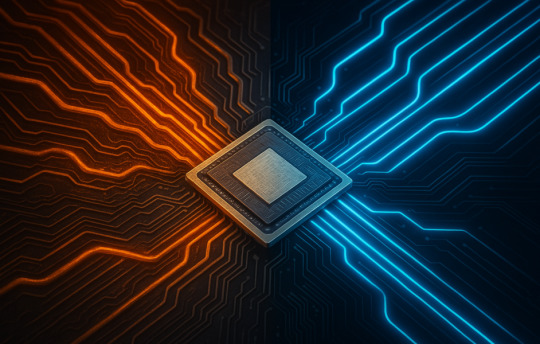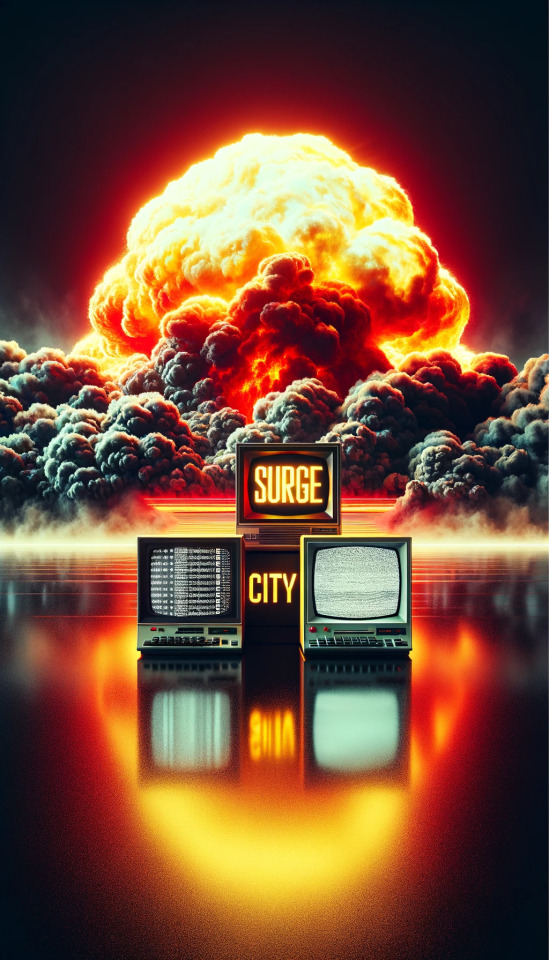#AI Accelerators
Explore tagged Tumblr posts
Text
BuySellRam.com is expanding its focus on AI hardware to meet the growing demands of the industry. Specializing in high-performance GPUs, SSDs, and AI accelerators like Nvidia and AMD models, BuySellRam.com offers businesses reliable access to advanced technology while promoting sustainability through the recycling of IT equipment. Read more about how we're supporting AI innovation and reducing e-waste in our latest announcement:
#AI Hardware#GPUs#tech innovation#ai technology#sustainability#Tech Recycling#AI Accelerators#cloud computing#BuySellRam#Tech For Good#E-waste Reduction#AI Revolution#high performance computing#information technology
0 notes
Text
Yes, microsoft trying to make a "zero-water" data center (https://finance.yahoo.com/news/microsoft-unveils-zero-water-data-170002064.html) is unambiguously a good thing. Obviously any reduction of pollution or water usage is a good thing. No, I don't think that means that ai's usage of water is something to singlehandedly be up in arms about.
By all means, be upset about ai! Just don't only be upset about ai for this or that when basically every other industry on the planet has the same exact problems.
A single cotton t-shirt requires 2700 liters of water, 5 trillion liters of water are used annually for fabric dying, and 20% of all water pollution is from garment production (source: https://www.wri.org/insights/apparel-industrys-environmental-impact-6-graphics)
This medium article (https://medium.com/@notkavi/stop-acting-like-ai-uses-a-lot-of-water-fafea5573c63) compares the numbers cited in the same study as the latest news articles about ai water usage ("Making AI Less 'Thirsty' by Pengfei Li et al https://arxiv.org/pdf/2304.03271) to the water needed to make beef. GPT-3 used as much water to train as it takes to feed 12 usamericans their average annual burger-patty supply. One quarter-pounder uses as much water as 36k GPT-3 queries or 3.6k GPT-4 queries.
Here is a comparison of Microsoft's water usage in 2022 to the water usage of golf courses:


In 2022, Microsoft claimed it used 1.7 billion gallons (6.44 billion liters) of water. Between 2003 and 2005, the golfing industry used approximately 2.08 billion gallons (7.87 billion liters) of water DAILY for course irrigation. (water usage of golf courses has dropped an estimated 29% between 2020 and 2005 - https://www.gcsaa.org/media/news-release/2022-news-releases/2022/07/26/golf-courses-reduce-water-usage-by-29-percent-according-to-national-survey - this still amounts to ~1.48 billion gallons or ~6.74 billion liters daily. 2 days of golf is more than a year of Microsoft's water usage)
Source for golf water use: https://www.usga.org/content/dam/usga/pdf/Water%20Resource%20Center/how-much-water-does-golf-use.pdf
Source for ai water use: https://www.standard.co.uk/news/tech/ai-chatgpt-water-power-usage-b1106592.html
Yes, the world would benefit from less water usage for ai. But when you posit ai as uniquely evil for it's water usage, I have a hard time believing you actually have an issue with the water usage. Instead it seems like you just want a reason to dislike ai.
My goal is for all of these industries, and many more, to severely reduce their water consumption, or to even stop existing as industries at all! Is that yours as well? If so, why doesn't it feel like it.
#I like having my sources be both clickable and copy-able hence the way this is formatted#I'm prepared to hunt for sources comparing other issues with ai but most complaints i have seen about ai's existence and ai's use#are merely a reflection of the problems of the status quo but accelerated. resources were being mined unethically;#now they're being mined faster. water is being used by the tech industry; now its being used faster.#electricity use is going up; now it's going up faster.#the state uses its power to kill and discriminate; now it can kill and discriminate faster.#yes none of these are good things. but they were all problems in need of solving before ai came into the picture.#and it is my belief that attacking ai alone is not going to actually solve any of these problems.#attack it in tandem sure; but that's not really the behavior i'm seeing.#if you spend all your time attacking the leaves; the stem will continue to grow unhindered
15 notes
·
View notes
Note
mods make them do stoichiometry
NO NO NO NO I just got HORRIBLE flashbacks I failed stoichiometry so bad when I took chem oh my god 😭 but yes… SUBJECT THEM TO STOICHIOMETRY RN MAKE THEM SUFFER
7 notes
·
View notes
Text

#onward#moving on#accelerate#faster#moving forward#recovery#alone with my thoughts#aesthetic#heartbreak#relationship#vibes#romance#space aesthetic#helmet#digital art#ai artwork#retvrn
6 notes
·
View notes
Text
very similarly to how the ai in education argument highlights the issues with academia in the first place I think ai in fandom highlights its issues as well. sure you can use ai for quick roleplaying just like you can use ai for assignments that would be more beneficial for the student to complete without it, but the majority of the stuff under scrutiny is slop.
The observable problem with academia is that the structures of it demand students output as pointlessly and efficiently as an llm, but with fandom it's harder to approach because no one wants to talk about the commodification and consumption of hashed and rehashed and triple hashed content. Even in the example I used about roleplaying, the motivation for that is to get a workable product quickly to skip to the activities in focus.
You can put it in idealist terms and say whoever does that doesnt have the "love for the game" but the reason for the phenomenon is the point of interest existing shifted towards consumption and away from creation. We all joke about tags being flooded by x reader imagines but honestly- there is a demand for slop driven by what informs fandom culture. either the people on the slop only diet make an llm spit it out or they start discourse over why no one's making it for them for free. The role of being a creator is just not in the equation here at all so arguing it with these hyper-passive consumers is pointless.
honestly I think it's reflective of the greater culture shifts that influence western fandom exagerrating. The less niche and perverted (using that word in the social division way) your interests are the closer the fandom experience will be to a sort of clout fueled service industry. this is where you see shit like creators getting frustrated that archive site mechanics like ao3's won't give them a useable clout output like social media sites, senses of entitlement for what is understood by the audience as voluntary but by the artist as unpaid labor requiring a form of payback. the split between monetization and communal collaboration blurs hard.
anyways my main point is that if you like a popular thing, and you like popular fandom cliches within the popular thing, there's no reason to be surprised or reactionary or upset a chatbot can do the same thing as the hundred of creators you look to for regular content: regurgitate in new and interesting patterns. or to be confused when the chatbots and llms are given the same level of reverence as those creators, which is a pedestal of officiality and nothing more
#not very well articulate so I hope this is understandable#thinking out loud#had to work hard not to cross the line into mainly arguing that the types of stuff people have started to use ai for are like Lesser lol#slop is mostly a neutral observation with a little judgement. to each their own yk#just trying to point out that there is a unique equation happening thats been happening in fandom for a while#and ai just makes it visible and accelerates it a little#lots of people get really set on thinking they can order around the real world like its a playground roleplay game#the powers and demands at play will do their own thing lol no matter how many angry psa's get posted#txt#opinions
2 notes
·
View notes
Text
Industry First: UCIe Optical Chiplet Unveiled by Ayar Labs
New Post has been published on https://thedigitalinsider.com/industry-first-ucie-optical-chiplet-unveiled-by-ayar-labs/
Industry First: UCIe Optical Chiplet Unveiled by Ayar Labs


Ayar Labs has unveiled the industry’s first Universal Chiplet Interconnect Express (UCIe) optical interconnect chiplet, designed specifically to maximize AI infrastructure performance and efficiency while reducing latency and power consumption for large-scale AI workloads.
This breakthrough will help address the increasing demands of advanced computing architectures, especially as AI systems continue to scale. By incorporating a UCIe electrical interface, the new chiplet is designed to eliminate data bottlenecks while enabling seamless integration with chips from different vendors, fostering a more accessible and cost-effective ecosystem for adopting advanced optical technologies.
The chiplet, named TeraPHY™, achieves 8 Tbps bandwidth and is powered by Ayar Labs’ 16-wavelength SuperNova™ light source. This optical interconnect technology aims to overcome the limitations of traditional copper interconnects, particularly for data-intensive AI applications.
“Optical interconnects are needed to solve power density challenges in scale-up AI fabrics,” said Mark Wade, CEO of Ayar Labs.
The integration with the UCIe standard is particularly significant as it allows chiplets from different manufacturers to work together seamlessly. This interoperability is critical for the future of chip design, which is increasingly moving toward multi-vendor, modular approaches.
The UCIe Standard: Creating an Open Chiplet Ecosystem
The UCIe Consortium, which developed the standard, aims to build “an open ecosystem of chiplets for on-package innovations.” Their Universal Chiplet Interconnect Express specification addresses industry demands for more customizable, package-level integration by combining high-performance die-to-die interconnect technology with multi-vendor interoperability.
“The advancement of the UCIe standard marks significant progress toward creating more integrated and efficient AI infrastructure thanks to an ecosystem of interoperable chiplets,” said Dr. Debendra Das Sharma, Chair of the UCIe Consortium.
The standard establishes a universal interconnect at the package level, enabling chip designers to mix and match components from different vendors to create more specialized and efficient systems. The UCIe Consortium recently announced its UCIe 2.0 Specification release, indicating the standard’s continued development and refinement.
Industry Support and Implications
The announcement has garnered strong endorsements from major players in the semiconductor and AI industries, all members of the UCIe Consortium.
Mark Papermaster from AMD emphasized the importance of open standards: “The robust, open and vendor neutral chiplet ecosystem provided by UCIe is critical to meeting the challenge of scaling networking solutions to deliver on the full potential of AI. We’re excited that Ayar Labs is one of the first deployments that leverages the UCIe platform to its full extent.”
This sentiment was echoed by Kevin Soukup from GlobalFoundries, who noted, “As the industry transitions to a chiplet-based approach to system partitioning, the UCIe interface for chiplet-to-chiplet communication is rapidly becoming a de facto standard. We are excited to see Ayar Labs demonstrating the UCIe standard over an optical interface, a pivotal technology for scale-up networks.”
Technical Advantages and Future Applications
The convergence of UCIe and optical interconnects represents a paradigm shift in computing architecture. By combining silicon photonics in a chiplet form factor with the UCIe standard, the technology allows GPUs and other accelerators to “communicate across a wide range of distances, from millimeters to kilometers, while effectively functioning as a single, giant GPU.”
The technology also facilitates Co-Packaged Optics (CPO), with multinational manufacturing company Jabil already showcasing a model featuring Ayar Labs’ light sources capable of “up to a petabit per second of bi-directional bandwidth.” This approach promises greater compute density per rack, enhanced cooling efficiency, and support for hot-swap capability.
“Co-packaged optical (CPO) chiplets are set to transform the way we address data bottlenecks in large-scale AI computing,” said Lucas Tsai from Taiwan Semiconductor Manufacturing Company (TSMC). “The availability of UCIe optical chiplets will foster a strong ecosystem, ultimately driving both broader adoption and continued innovation across the industry.”
Transforming the Future of Computing
As AI workloads continue to grow in complexity and scale, the semiconductor industry is increasingly looking toward chiplet-based architectures as a more flexible and collaborative approach to chip design. Ayar Labs’ introduction of the first UCIe optical chiplet addresses the bandwidth and power consumption challenges that have become bottlenecks for high-performance computing and AI workloads.
The combination of the open UCIe standard with advanced optical interconnect technology promises to revolutionize system-level integration and drive the future of scalable, efficient computing infrastructure, particularly for the demanding requirements of next-generation AI systems.
The strong industry support for this development indicates the potential for a rapidly expanding ecosystem of UCIe-compatible technologies, which could accelerate innovation across the semiconductor industry while making advanced optical interconnect solutions more widely available and cost-effective.
#accelerators#adoption#ai#AI chips#AI Infrastructure#AI systems#amd#Announcements#applications#approach#architecture#bi#CEO#challenge#chip#Chip Design#chips#collaborative#communication#complexity#computing#cooling#data#Design#designers#development#driving#efficiency#express#factor
2 notes
·
View notes
Text
Why Quantum Computing Will Change the Tech Landscape
The technology industry has seen significant advancements over the past few decades, but nothing quite as transformative as quantum computing promises to be. Why Quantum Computing Will Change the Tech Landscape is not just a matter of speculation; it’s grounded in the science of how we compute and the immense potential of quantum mechanics to revolutionise various sectors. As traditional…
#AI#AI acceleration#AI development#autonomous vehicles#big data#classical computing#climate modelling#complex systems#computational power#computing power#cryptography#cybersecurity#data processing#data simulation#drug discovery#economic impact#emerging tech#energy efficiency#exponential computing#exponential growth#fast problem solving#financial services#Future Technology#government funding#hardware#Healthcare#industry applications#industry transformation#innovation#machine learning
3 notes
·
View notes
Text
talking to myself is so fucked up when im hilarious. what if im getting a good grade in vocal stimming and no one hears
#a iba voice hi im the computer yr not getting that#mods shove him into a particle accelerator. that is not good 😥#its been a While since i played ai so the aiber voice is a little rusty and keeps getting crossed w my alexa and tiktok tts voices#which are honestly objectively funny to have considering im. more of a date irl#(bro yr machine is masc as fuck)#so i talk to people in those voices sometimes as a bit and theyre like HELLO.#ive actually been told my voice sounds like tomo dub.which is realness because i love her#someone should compile clips of that shows dub because theres Moments#maybe ill do it those get views
7 notes
·
View notes
Text
Did I just write 2000+ words of nothing but Chen Yi and Ai Di fucking?
Yes.
You bet your ass I did.
#fanfiction#smut is my creative accelerator#sorry not sorry#now I just have to get the non-smut parts finished#that's the hard part though lol#chenai cp#chen yi x ai di
5 notes
·
View notes
Text

#ai art#ai art community#dalle3#explorations#graphic design#surge city dreams#life in accelerated times
2 notes
·
View notes
Text
Money Spines Paper Lung Kidney Bingos Organ Fun

lions are very mean and like jellyfish
73K notes
·
View notes
Text
AMD acquires engineering team from Untether AI to strengthen AI chip capabilities
June 9, 2025 /SemiMedia/ — AMD has acquired the engineering team of Untether AI, a Toronto-based startup known for developing power-efficient AI inference accelerators for edge and data center applications. The deal marks another strategic step by AMD to expand its AI computing capabilities and challenge NVIDIA’s dominance in the field. In a statement, AMD said the newly integrated team will…
#AI inference accelerator#AMD AI chips#data center GPU#edge computing chips#electronic components news#Electronic components supplier#Electronic parts supplier#power-efficient AI#Untether AI acquisition
0 notes
Text
i fiddle with ai sometimes because i have a cluster b personality disorder and struggle with the empathy involved in giving a shit about the fact its data is trained on stolen assets but like
all fiddling with image gen does is make me want to start drawing again because my art is significantly better than whatever the fuck this thing outputs even if the ai gen is visually very like normie art consumer polished. it clearly lacks like. conceptual soul, as in like it's clearly not being thought about the conceptual reasoning behind specific details and attributes because it literally can't think about it. so everything it makes is just hollow and empty, like looking at a human with no life behind their eyes.
it sucks that art consumer normies don't notice this though but i think that's just an issue artists have faced for millennia. artwork is a exertion of creational conscious will that produces on several simultaneous layers of conceptual thought whereas ai can only crudely imitate the end result of that which clearly possess no substance whatsoever. art isn't just a statistical average like the floating point pixel assemblies ai produces.
i guess this is part of why i never felt particularly threatened by ai but it's certainly insulting when ai bros think they're artists. lol
#though i think the main reason i dont feel threatened by ai is i never drew for like clout and likes or whatever#i just started drawing to get concepts out of my head to show other people#my main gripe with ai is it's accelerating the death of the internet but maybe thats a good thing at this point honestly
0 notes
Text
We all knew Rohit's philosophy was "permabulk", we just didn't know how that included growing a foot in height in addition to the 140 kg of size he'd packed on. Yes, it took ten years, but it left hs wondering: where would he be in another ten years?
464 notes
·
View notes
Text

Top 10 Mistakes To Avoid When Validating Your Idea
If you’re serious about turning your concept into a successful business, you must avoid the following top 10 mistakes during idea validation — and consider using advanced platforms like ProtoBoost, an AI-driven idea validation system��that simplifies this entire process.
#ai-powered product innovation#protoboost#product launch accelerator#prototyping#ai idea valitaion#rapid prototyping with ai#ai-driven prototyping
0 notes
Text
For years, enterprises have stitched together automation tools—RPA bots, workflows, APIs—hoping to fix broken processes. But the real bottleneck was never just about moving data faster. It was about decisions. That’s where Digital ClerX, a vertical AI agent platform, changes the game. Built for industries like healthcare, finance, insurance, and manufacturing, Digital ClerX deploys intelligent agents that don’t just automate tasks; they understand context, adapt in real time, and collaborate to complete entire workflows autonomously. From streamlining claims processing to accelerating procure-to-pay, it delivers domain-specific, secure, and scalable automation that works across your enterprise systems—without the manual effort. Designed for outcomes, Digital ClerX helps organizations shift from fragmented automation to orchestrated intelligence.
0 notes